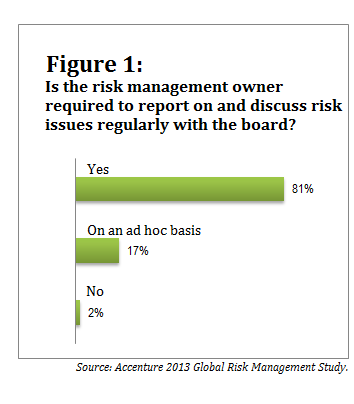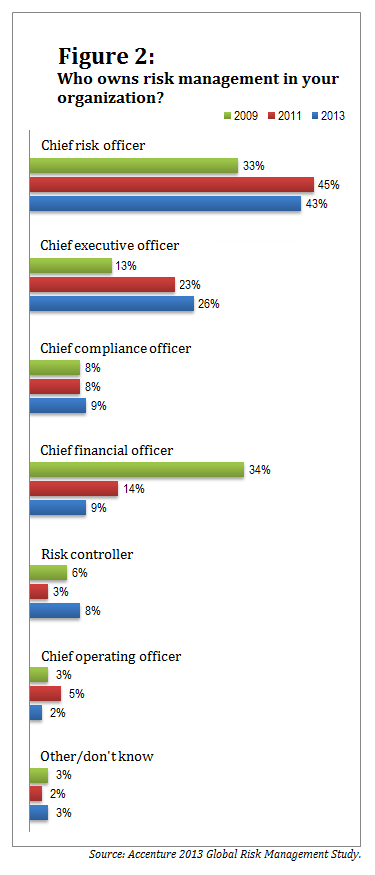As global business risks intensify, risk management is taking onan increasingly important role in companies around the world. Arecent Accenture survey underlines this shift. Titled “RiskManagement for an Era of Greater Uncertainty,” the studyincluded respondents from 446 organizations around the world.Ninety-six percent said their business has an individual whofunctions as the chief risk officer, although in some cases withoutthe formal title “CRO.” This is up substantially from the 78percent of companies in Accenture's 2011 survey that had designateda chief risk officer.
|Perhaps even more telling, the person responsible for riskmanagement has the ear of these companies' senior leaders. In 81percent of surveyed organizations, the risk management ownerdiscusses risk issues with the board of directors on a regularbasis (see Figure 1). In addition, in many organizations, riskmanagement has moved from the responsibility of finance to falldirectly within the domain of the CEO. (See Figure 2,below.)
Treasury & Risk sat down with Steve Culp,global managing director of risk management for Accenture, to talkbriefly about the survey's findings.
||
T&R: Four years ago, riskmanagement fell under the jurisdiction of the CFO in 34 percent oforganizations. Today, that's true in only 9 percent oforganizations. What has caused this shift?
|Steve Culp: Due to the global financialcrisis, risk management ownership has experienced major shifts. Notonly was risk management elevated into an executive board-levelposition, but it was also reassigned from the CFO to the CRO andCEO roles. Since the first “Global Risk Management Study” in 2009,the share of organizations for which the risk owner is either theCRO or CEO has risen from 46 percent to nearly 70 percent.
|In 2009, when Accenture first undertook the study, riskmanagement was moving beyond compliance, and by 2011, it wasbecoming a source of competitive advantage for many businesses.Today, risk management is increasingly connected within multipleaspects of organizations, including governance and leadershipstructures, analytics and reporting outputs, integration andalignment with other key functions in the investment anddecision-making processes, and importantly in the talentagenda.
|What is really driving this trend is the increased recognitionof the importance within businesses, as shown in this year's surveyresults.
|At a time when the rules of the game are increasingly changing,businesses need risk leaders to assess where they are today andwhat they need to do so they can plan the course ahead.
|T&R: What are the other importanttrends in risk management that you're seeing today?
| SC: What we see in themarketplace, and what we heard from the survey respondents, is thatthe role of risk management is rapidly evolving. The vast majority(98 percent) of survey respondents report an increase in theperceived importance of risk management at their organization,giving more emphasis to its integration into decision-making.
SC: What we see in themarketplace, and what we heard from the survey respondents, is thatthe role of risk management is rapidly evolving. The vast majority(98 percent) of survey respondents report an increase in theperceived importance of risk management at their organization,giving more emphasis to its integration into decision-making.
The study also found large gaps between the expectations ofsenior management for risk mitigation outcomes and their perceptionof their risk function's performance in those areas. Forexample, 95 percent identified the importance of reputationmanagement, but only 28 percent said their risk team has providedsupport in that area. Managing volatility was considered importantby 70 percent of respondents, but only 21 percent said the riskteam contributed to such initiatives.
|T&R: What riskmanagement-related skills do companies tend to be lacking, and whatthey can do about it?
|SC: As a consequence of the growingdemands for risk management amid talent shortages, I am seeinglarge gaps between senior management expectations for riskmitigation outcomes and the risk function's performance—and ourfindings echo this. Despite 58 percent of the surveyedorganizations reporting they had grown their risk management teamover the last two years, many of those who participated in ourstudy reported shortages of talent in a number of areas. Forinstance, 54 percent reported a shortage of candidates with theright skills to help them cope with an increasingly uncertain risklandscape. Talent shortcomings are hindering organizations' abilityto successfully execute against business objectives. That is aprimary obstacle in leveraging technology and data to support therisk management function.
|A shortage of analytics skills in risk management compounds theproblem. Sixty-one percent of our survey's respondents reportedshortages in this area. Technology also plays a critical enablingrole, but highly qualified talent is needed to ensure thesuccessful application of these tools to improve risk managementcapabilities, and 60 percent of our respondents reported shortagesof risk technologists. Those who excel tend to nurture a range ofanalytics skills that are specialized in the various aspects ofrisk management.
|
Complete your profile to continue reading and get FREE access to Treasury & Risk, part of your ALM digital membership.
Your access to unlimited Treasury & Risk content isn’t changing.
Once you are an ALM digital member, you’ll receive:
- Critical Treasury & Risk information including in-depth analysis of treasury and finance best practices, case studies with corporate innovators, informative newsletters, educational webcasts and videos, and resources from industry leaders.
- Exclusive discounts on ALM and Treasury & Risk events.
- Access to other award-winning ALM websites including PropertyCasualty360.com and Law.com.
*May exclude premium content
Already have an account? Sign In
© 2024 ALM Global, LLC, All Rights Reserved. Request academic re-use from www.copyright.com. All other uses, submit a request to [email protected]. For more information visit Asset & Logo Licensing.






